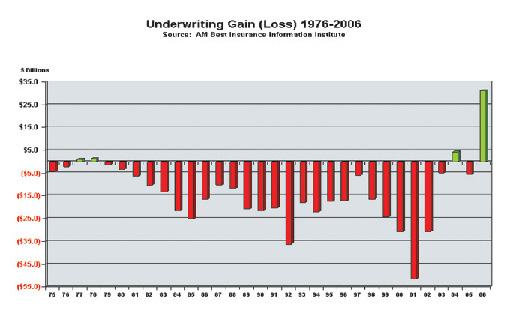The insurance marketplace has been characterized throughout 2007 as competitive. Buyers with good loss histories have experienced reductions on all lines of insurance throughout the 2007 renewal cycle. Carriers have significant capacity; returns on investment have been strong and lower than expected catastrophic losses have all contributed. Average rate levels for most lines of coverage have been trending flat to lower throughout the first quarter of 2008. What should we expect for the remainder of 2008? Rates will likely continue to be competitive, the investment outlook could deteriorate and no one knows what the future will bring regarding catastrophic loss. As the chart below shows, the market tends to harden when underwriting losses reach their largest point (1984, 1992 and 2001). We are in a period of historically high underwriting profits; however this picture could change with a drastic reduction of investment income or catastrophic losses. In our opinion, the marketplace is at best uncertain. If a catastrophic loss event occurs the pillars holding up the soft market could crumble rapidly.
Some notable news in 2007 includes the recent enactment of the Terrorism Risk Insurance Program Reauthorization Act (TRIPRA). This new laws extends and modifies TRIA. Some of the key changes are:
*TRIA has been extended for seven (7) years, expiring on December 31, 2014;
*The definition of "act of terrorism" under TRIA has been expanded to include "domestic terrorism";
*The new law explains how the $100 billion cap on losses operates;
*TRIPRA accelerate the means by which the federal government will recoup insured losses through policy surcharges.
Insured's can expect to receive new disclosure notices including the latest information about TRIA. Many policies written during 2007 prior to the implementation of the new law contained "sunset" provisions on the terrorism endorsement. Insured's could receive additional premium bills relating to the new terrorism extension. We would advise all insured's work closely with their property insurance carrier to negotiate the terms of any extension of the TRIA coverage.
Commercial property coverage has led the way in the soft market cycle of 2007 and 2008. The catastrophic (CAT) insurance market has shown some signs of increased capacity however renewals for risks throughout the wind and flood prone areas remain difficult. Carriers' competing for clients outside the catastrophic locations of the gulf coast and Calif. created a marketplace more competitive than it has been in years. Insured's are able in most cases to reduce rates, reduce deductible, increase coverage all at the same renewal. While the market is predicted to stay competitive in 2008; we anticipate rate reductions will not match those of the last half of 2007. Companies should use the current soft market cycle to complete capital improvements that will enhance the risk in the eyes of the carriers. This will help stabilize your future rates in the event the market changes due to the factors detailed earlier in this article.
Primary Casualty insurance (general liability and umbrella) has continued to show signs of softening. The direct correlation between carrier surplus and rate will continue to have a softening impact on the casualty markets throughout 2008. Albeit at a modest pace, insured's should expect renewal options to be flat to modest reductions in rate. Favorable loss histories will dictate the outcome of the casualty renewal cycle. Investment in loss prevention along with claims management and contractual controls will enhance your risk in the eyes of the underwriting community.
Workers' compensation is the most regulated line of commercial insurance and as such has shown the least volatility. The vagaries of individual state laws and regulatory oversight dictate the insurance markets response to availability and pricing.
Executive Management Liability insurance continues to show competitive signs. Baring a meltdown due to the sub-prime mortgage dilemma general markets forces should continue to keep softening pricing pressure on carriers. However, we continue to watch this segment closely. Although frequency of claims is down; severity trends of the class action suits continue to increase. Companies with global operations or expansion plans should consult with their broker regarding the evolution of corporate laws expanding the duties of directors and officers and shareholders rights in many foreign jurisdictions. Coverage voids may exist for foreign D's and O's at subsidiaries of U.S. parent companies. Purchasing local D&O policies in countries that do not recognize non-admitted U.S. D&O policies might be a prudent option.
Looking forward we predict the market will remain soft to stable subject a lack of catastrophic events. In a recent survey conducted by the National Insurance Brokerage Association, 66% of the brokers surveyed experienced rate reductions on their renewals through the first quarter 2008. In addition, the survey showed 30% of the brokers feel the market will remain flat and 30% feel the market will continue to be soft.
Will this be the calm before the storm no one knows? It will be however extremely important for insured's to build strong relationships with their underwriters so if the market changes you are able to limit the impact. Strong loss prevention measures combined with claims management and contractual standards are increasingly important, thereby presenting the best possible risk to the underwriters. Building strong risk management relationships with your broker and underwriters creating strategic risk partnerships will assure stable renewals for years to come.
Spencer Macalaster is a senior vice president with Risk Strategies Co., Boston.
Tags:
The insurance marketplace in 2008: What can we expect for the rest of the year?
February 27, 2008 - Front Section










